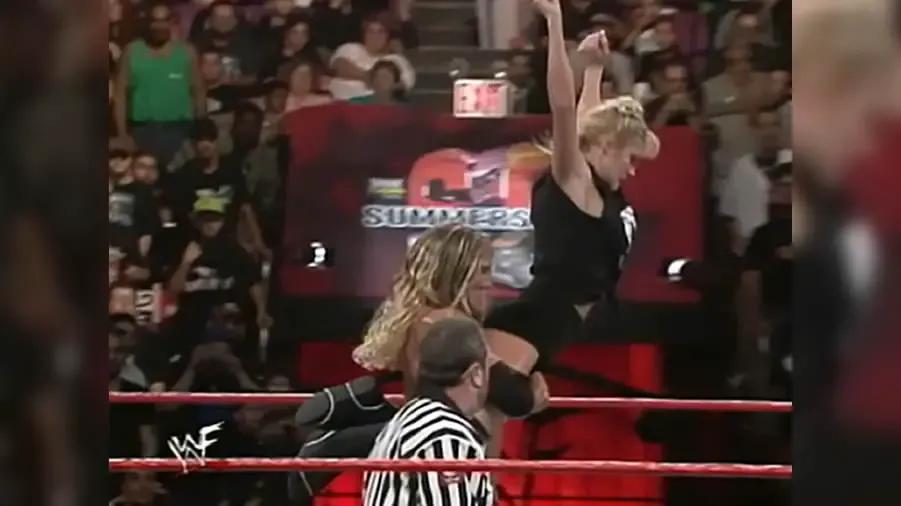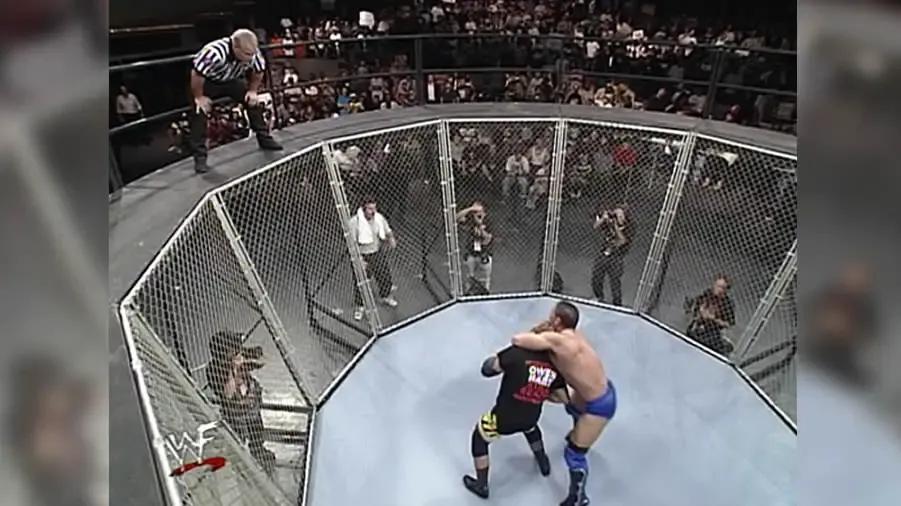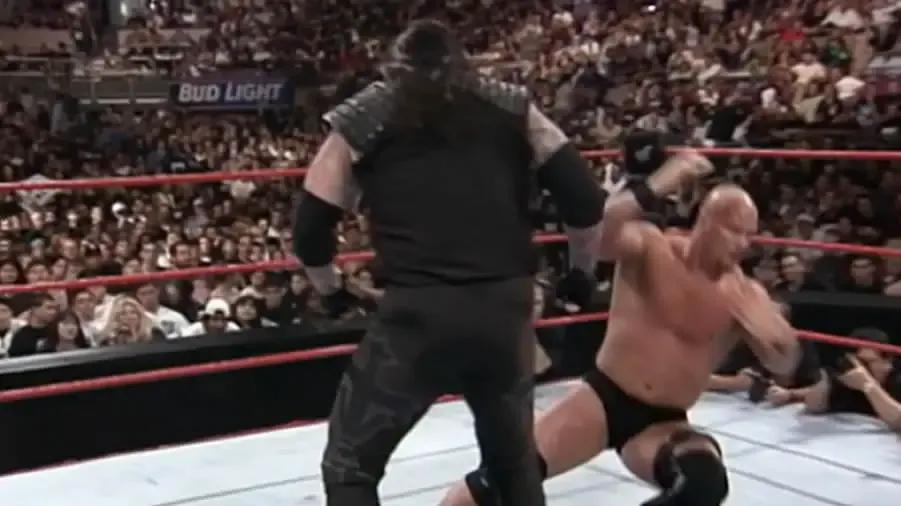10 Things We Learned From WWE SummerSlam 1998
The Undertaker inadvertently knocks out Stone Cold Steve Austin...

Jul 31, 2018
Has it been 20 years already? The summer of 1998 was a time of rap metal, Surge soda, way-too-baggy jeans, and trash TV by the bucket load. And there was no trash TV like crash TV, as WWE Attitude was in full swing, rife with penile humour, excessive violence, near-nudity, and enough swear words per capita to make Quentin Tarantino go prudish. I know, I miss those days too.
While some of the WWE fodder of the day hasn't exactly aged well, SummerSlam 1998 is an obvious exception, as it remains one of the most well-built, highly-anticipated, and brilliantly-executed events in WWE history. From the time The Undertaker did Stone Cold a solid by playing equalizer to Vince McMahon's stacked deck at Over the Edge, "The Phenom" and the WWE Champion were on a collision course, with Madison Square Garden the only locale worthy of their battle.
SummerSlam 1998 was one of those shows that nailed a ringer on multiple fronts, from delivering on money main events, to giving tomorrow's main eventers the perfect forum to shine, to just flat out entertaining WWE's
home crowd
with a variety of styles. SummerSlam 1998 is generally mentioned among the finest 'Slams in the two-and-a-half dozen of them, and it's hard not to see why.

Even though D-Lo Brown was generally backed up by hooligans from his Nation-mates, and Val Venis was mostly put to use as a character more so than as a straight-up wrestler, the two cobbled together a very good opening match for Brown's European Championship. The only blight on the opener was that it ended on an unsatisfactory DQ finish when Venis lost his temper and struck the official. The crowd didn't much care for that finish, and made their displeasure clear.
It would be one of the few moments in which the heroes didn't triumph, as D-Lo Brown was the only heel that would win on the actual pay-per-view card. While babyfaces did lose other matches (Undertaker, an on-the-fence Mankind), that would be the only case in which a face's winning hopes were snuffed out by a clear villain. Even then, Brown didn't even garner a pinfall or submission victory. This was a night for the good guys (and gal).

When WWE instituted a Light Heavyweight division in 1997, it was a clear attempt to try and counter WCW's exciting Cruiserweight action, but that would prove difficult. WCW had already cornered the market on the best and brightest out of AAA, to go along with some other North American thoroughbreds. The best that WWE had to counter with was Taka Michinoku, who was made the division's first champion in December 1997, after he had captivated fans with his affability and daredevilry.
By the time the dust settled on Taka's victory over Aguila at WrestleMania XIV, his run as division kingpin was pretty much null. He would not defend the belt on PPV again for almost seven months, as his next three appearances on a WWE monthly special were in multi-man matches. At Over the Edge and King of the Ring, he opposed the stable known as Kaientai, whereas he would end up teaming with them in a
comedy
match against the Human Oddities at SummerSlam. By the time Taka and his fellow imports were made to look foolish, any remaining hope that WWE would do right by the lightweights was certainly dashed.

Hair vs. Hair matches can be truly thrilling if the defeated villain is one that fans are happy to see get an unwanted fade in front of the world. This was the case when it came to Jeff Jarrett, as he was as far from the babyface realm as one could get. Add the fact that his opponent was beloved DX hooligan X-Pac, and it was a case of
b
etter him than Pac.
When Sean Waltman went to join the New Age Outlaws, Howard Finkel, Droz, and The Headbangers (the latter few unwanted haircut victims of Jarrett's in the preceding weeks) in giving Double J a trim of his own. Only problem: the electric clippers malfunctioned, according to Waltman. Instead of giving Jarrett the Kojak treatment, the trimmers broke down only part-way into the job, necessitating the use of scissors. But because the cut was now taking too long due to the use of manual cutters, they had to abandon the haircut after minimal work had been done. Ah well.

By the time SummerSlam 1998 rolled around, Edge had been on the active roster for a little more than two months, though he had yet to live up to any sort of favourable expectations. Though he had a great look and a certain silent charisma about himself, he was still in search of a moment that would help carve out his personal niche. Working SummerSlam in a mixed tag match alongside Sable was just the milestone Edge needed.
Though Sable would be getting the pin on future ex-husband Marc Mero in the match, Edge knew he needed to make himself seen in some way. Thus, he pitched the finish to the match: he would drop Sable out of a Wheelbarrow Drop onto a prone Mero, making for the most creative of conclusions. Edge had previously done the move on the indies with Christian as the one getting dropped.

The Lion's Den match pitting Ken Shamrock against Owen Hart was a wonderfully-constructed bit of mixed martial arts combined with sports entertainment theatricality, and added some necessary variety to the event. The pseudo-fight itself was held inside Felt Forum, an internal theatre tucked inside Madison Square Garden, which would seat additional WWE fans during sellouts at the Garden who would then watch the monthly shows via beamed-in closed circuit video.
The Wrestling Observer Newsletter noted that while SummerSlam itself was a lucrative piece of business, the theatre seating wasn't a big part of the event's success. While the theatre at the time could seat a little under 5000 patrons, only 2500 filled the Felt Forum, with only about 1800 of them paid. Dave Meltzer chalked up the paltry number to the obvious death of closed circuit screening, as the pay-per-view monster had chewed up that avenue pretty thoroughly. After all, why pay a ticket to see a pay-per-view (with one match
up close
) when you can watch the pay-per-view from the comfort of your own home, and not have to pay for parking?
The Handicap Match for the WWE Tag Team championships was mostly a backdrop for spelling out the dissolution between Kane and Mankind, all but turning Mankind face in the process. It was neither the first nor last match to make the winners seem like inconsequential scenery, but Kane's violent post-match attack on Mankind overshadowed a unique accomplishment on the part of one (Or rather, "The One") Billy Gunn.
With the victory alongside New Age Outlaws partner Road Dogg, Gunn became the first person in WWE history to have six different reigns as a Tag Team champion. Previously, Gunn sat at five reigns with Mike Rotunda, Tony Garea, and Mr. Fuji, before winning his sixth Tag belt (three with Road Dogg, three with Smoking Gunns' brother Bart). As of today, Gunn sits at 11 Tag Team belts under the WWE header, three behind the current record-holder, Edge.

Fans inside the Garden and out knew they had witnessed something special by the time The Rock and Triple H's Ladder Match for the IC title drew to a close. In a time when ladder matches were much rarer sights, the idea of such a match was a treat, and what a treat it was. Both men, Rock especially, gave star-making performances that would help elevate both from the upper-midcard into the main event, with few disputing either man's ascent.
To make the match even more impressive, Triple H managed to get through the Match of the Year candidate on a severely injured knee. Helmsley had sustained the injury weeks before the pay-per-view, and the pain would necessitate cancelling a practice Ladder Match scheduled for a house show shortly before the pay-per-view. Unfortunately for Triple H, his injury would linger, and he would have to vacate the belt before the end of September. He would miss a little more than two months of action following surgery.

The Rock's loss of the Intercontinental Championship only freed him up for a run to the top of the card, as has long been the story of some of the truly great IC titleholders. Overall, Rock reigned with the belt for 265 days, dating back to when Steve Austin disinterestedly handed the belt over to him in December 1997. Though Rock was the first wrestler in more than five years (Shawn Michaels in 1992-93) to have a reign that topped 200 days, such a reign was in line with lengthy runs of eras past.
Rock would also be the last 200+ day IC titleholder until another third generation star, Randy Orton, did the same. Orton's 210-day reign in 2003-04 would catapult him into the main event tier as well, but not the same level of Hollywood stardom (That's What I Am is no Fast and Furious film). Because of the frequent title changes in the general Attitude Era, the only man between Rock and Orton that even held the IC belt for 100 days was Ken Shamrock, whose 125-day reign ended in February 1999.

For a little while there, it seemed like Stone Cold was destined to never be able to enjoy a SummerSlam moment. He managed to overcome his horrifying spinal injury at the hands of Owen Hart in 1997, winning two WWE Championships in the year after his comeback, and would headline SummerSlam against The Undertaker in '98, capping off a summer's worth of drama and intrigue. If only Austin could've remembered the moment personally.
Though nowhere near as bad as the neck-crunching stinger from a year earlier, Austin would end up concussed on a very subtle botch. Charging off the ropes, Austin kicks a hunched-over Undertaker, causing 'Taker to stand straight up, and the back of his head would whack Austin in the chin. Austin was knocked loopy for several seconds, and while the match was still pretty good, The Texas Rattlesnake admitted to being disappointed with how it came off, feeling he and Undertaker didn't hook the crowd the way they could have.
Austin has recalled on his podcast how Earl Hebner looked down at him after the clash of heads and said "God Damn boy, you alright?" with Stone Cold replying "where am I?"
Earl then humorously said back: "God Damn, boy, you in the Garden!"

When WrestleMania XIV drew 730,000 buys five months earlier, it was a clear sign that any rumours of WWE's demise were greatly exaggerated. With Stone Cold leading the way, the Attitude Era was all about bigger numbers: more money, higher ratings, more eyeballs, more, more more. SummerSlam 1998, thanks to a combination of both the pro wrestling boom and a well-hyped, highly-anticipated event, drew more pay-per-view buys than any SummerSlam before or after it.
In all, the event did 700,000 buys, leaving the 235,000 from the year before deep in the dust. Not only is that 700,000 the highest buyrate for any SummerSlam, but it's also higher than any Royal Rumble, any Survivor Series, as well as 12 of the 29 WrestleManias that preceded the Network era. The only non-WrestleMania than ever did a higher buyrate than SummerSlam 1998 was the 2001 Invasion pay-per-view, as the half-assed WWE-WCW turf war was good for 770,000 buys.